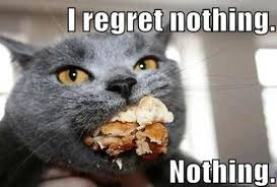I have just finished a book chapter for a edited collection on alternative food politics. The chapter is entitled ‘Vitalities and visceralities: alternative body/food politics in new digital media’ (the full chapter preprint is available here).
In the chapter, I focus on the ways in which human bodies and food consumption are represented in social media platforms like Facebook, Tumblr, Twitter, YouTube and Instagram using visual media such as selfies, videos, memes and GIFs, and organised with the use of hashtags. Once I began searching for this material online (using search terms like ‘fat memes’, ‘food porn’, ‘food GIFs’, ‘fitspo’, ‘vegetarian’ and ‘pro ana’), the strength of emotions expressed about bodies and food was particularly noticeable.
Bodies and food in digital portrayals express and circulate visceral feelings that are often dark, centring around broader ambivalences concerning human and nonhuman corporeality. For example, disgust and repulsion for food that is not ‘clean’ or is high in calories and for fat bodies that are considered to be undisciplined was a key theme. This reached its apotheosis in images and discussions relating to self-starvation practices, in which food consumption of any kind was portrayed as contaminating the ideal of the extremely thin body.
A contrasting portrayal, however, was that of the transgressive pleasures of excessive food consumption, often as resistance to body shaming and food policing. In the digital media I examined, vegetarians and vegans were often positively portrayed for their ethical and healthy food stance, but also derided as bores and moralisers. The promotion of fleshiness and excessive food consumption was found in fat activist and body positivist digital media, but also in the grotesque feats of cooking and eating dude food performed by the ‘Epic Meal Time’ men and food-related GIFs and memes.
Food consumption in these media was often sexualised. People uploading or sharing ‘fitspo’ images idealised slim, toned bodies, both male and female, displaying their physiques in tight, revealing gym or swim wear. Supporters of the pro-anorexia ‘bonespo’ meme portrayed emaciated young women as beautiful and sexually appealing. The ‘notyourgoodfatty’ approach highlighted the sensuality and erotic appeal of both fat bodies and excessive food consumption.
More disturbingly, the ‘Epic Meal Time’ YouTube videos made frequent references to the erotic appeal of meat the suggested women were meat for the consumption of men. This misogynistic approach was even more evident in memes and GIFs about meat, in which men were portrayed as aggressors and women their prey.
I conclude the chapter by arguing that expressions of alternative food politics in new digital media are underpinned by affects that display broad and deep-seated ambivalences about what kind of food is morally and ethically justifiable and what types of bodies people should seek to achieve. In some cases, the emotional power that animate the agential capacities of these types of media can impel transformation and change in the interests of alternative food politics. In others, they express and facilitate conservative and reactionary responses, serving to reproduce and magnify dominant norms, moral meanings and practices about ideal bodies, sexuality, and gender.







